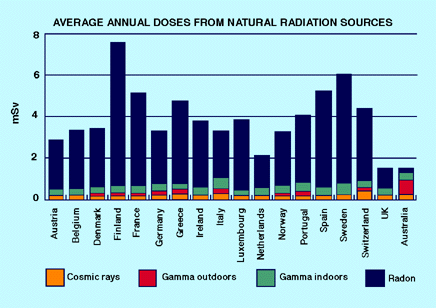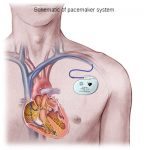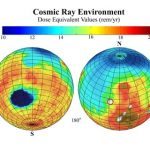Radiation is a common word, but in space weather studies, there are two types that differ in important ways.
Matter – in the form of electrons, protons and the ions of various atoms, which travel much slower than the speed of light.
Electromagnetic – In the form of X-rays, visible light, gamma rays and other forms of energy that travel at the speed of light.
Radiation: most of us have an instinctive fear of it. Even the word, itself, is cloaked in mystery and a sense of foreboding. In reality, we are all more familiar with radiation than we suspect. No matter where you live, you receive 15-20 chest X-rays each year of environmental radiation – and there is almost nothing you can do about it. Even solar storms add their share to this cargo of potential damage. The figure above is from the World Nuclear Association
As you sit reading this page, you are being pummeled by various forms of electromagnetic energy from visible light to radio waves. You are also being struck by the daughters of particles that have streamed, literally, from the far corners of our universe. In casual conversation, these kinds of energy are simply called ‘radiation’ even though physicists have known for over a century that their various forms are quite different. Electromagnetic radiation includes the familiar rainbow of the visible spectrum, crammed between a vast range of other waves traveling at the speed of light. Some of these can be stopped by a sheet of ordinary paper. Other more energetic forms of light, like X-rays and gamma rays, require ever increasing thicknesses of matter to abate them.
In a separate category of radiation we have fast-moving particles which also come in several basic types such as electrons, protons, and the nuclei of the elements heavier than hydrogen. The amount of damage that these material forms of radiation can inflict depends on how much energy each particle is carrying. The bigger the energy, the more punch they can deliver, and the more collateral damage they produce as they penetrate the skin of a spacecraft, or the tissues in an organism. Electromagnetic radiation in the ultraviolet can give you a sunburn, but energetic particles can bore their way into your cells and explode like a small bomb, ‘nuking’ a gene.
Just as we can measure temperature in terms of ‘degrees’, it shouldn’t surprise you that we can also measure the impact that radiation makes: Scientists call it a ‘rad’. When a specific form of radiation delivers one watt of energy into 100 kilograms of tissue, this is one rad. Not all radiation affects tissue equally, so health physicists prefer to use another unit, the rem, to give an actual dosage equivalent for the different types or radiation as they impact biological tissue. For example, in one second, one watt of alpha particles (stripped helium atoms ejected by the decay of heavier radioactive atoms) causes 20 times more damage than absorbing the one watt of X-rays or gamma-rays. So, for one rad of absorbed dose, you get exactly one rem of equivalent dose if you are talking about X-rays, and 20 rems if you are talking about the more destructive alpha particles. You definitely want to stay away from alpha particles!
So what does all this mean in practical terms?
Here is an inventory of the common levels of radiation exposure you get every year:
Radon gas, a natural by-product of certain radioactive elements found everywhere in the crust of the Earth, especially in granite-rich rocks, and clays. You probably never heard of radon gas until you bought, or sold, your first house. The radon gas hazard is the highest one we have to deal with, which is why basement radon gas monitors are a mandated part of home sales and purchases in the United States. This gas produces about 130 millirems per year of background radiation in your house.
Environmental – the ground around your feet, the cement and brick in your homes, emit radiation from their infinitesimal loads of trapped radioactive debris to the tune of about 60 millirem per year, but this changes quite a bit depending on where you live. For example, in states like Georgia, California, Florida and Maryland the terrestrial background radiation level is between 50-70 millirems per year, in Louisiana it is as low as 30, and in Colorado and South Dakota it can be as high as 115. The difference between living in Louisiana and Colorado is equal to an additional four chest X-rays per year added to your lifetime total. If you really want to live on the edge, you have to visit places like Kerala, India, where the thorium-rich sands give you a dose of 380 millirem every year, and in Guarapari, Brazil where you get a sizzling 600 millirem per year. In comparison to the natural background sources and their variations, one wonders why so many people worry about one versus two extra chest X-rays per year. If you want a big savings in exposure, just move to a seacoast town, and forget about prolonged vacations in Denver, Brazil or India.
Foods etc – When you add up the inhaled and ingested isotopes found in potassium and carbon this alone is equal to 23 millirems per year. Your own body is, itself, a low-grade source of nuclear radiation. If you are worried about your radiation risks, you should probably stop eating bananas (rich in radioactive potassium isotopes). You should also give up smoking (40 millirem per year, for a one pack a day habit).
If these were the only natural sources of radiation, you would already have a typical annual exposure of near 210 millirems or about ten chest X-rays per year. There is hardly anything you can do about this except move to Louisiana, stop eating bananas, and don’t spend time in your basement.
Cosmic Rays – As these particles stream into our solar system, the solar wind and magnetic field serves as a weak umbrella to deflect the less energetic cosmic rays. As the remaining higher-energy cosmic rays penetrate deeper into the solar system, individual planetary magnetic fields deflect still more of them. Eventually, the most energetic cosmic rays make it all the way into the Earth’s atmosphere where they collide with nitrogen and oxygen atoms to produce secondary ‘showers’ of energetic particles. These particles travel all the way to the ground and immerse the biosphere in a steady rain of particles, day-in and day-out. What this means for you and me is that a person living in Denver, the ‘Mile High City’, or in Laramie, Wyoming basks in an annual cosmic ray dosage of 120-130 millirems per year, while someone living in a seacoast town would only receive about 35 millirems. Travelers to remote mountaintops don’t have to worry about bringing lead underwear to protect themselves. But it is true that prolonged stays on mountain peaks higher than 14,000 feet brings with it more than just the exhilaration of the experience. The cosmic ray drizzle bathes you with an invisible and relentless shower of radiation with each passing day.
So, depending on where you live you can expect to receive 300 millirems of radiation per year. Taking this over your entire body for a full year is unavoidable, and by definition ‘safe’. We have been doing this for thousands of years. The only ill-effects are the typical, annual cancer rates we have to endure as a species because of the unavoidable genetic damage that is done.
For radiation exposure to really make you sick and die, you have to receive a lot of it in a short time. In terms of the Rad unit where 1 Rad of X-rays equalled 1000 millirem, we can estimate the various levels of sickness and death from different radiation dosages that are administered in a short period of time over the entire body (from an atomic bomb blast for example):
0-50 rads – No obvious short-term effects
80-120 rads – You have a 10% chance of vomiting and experiencing nausia for a few days
130 -170 rads – You have a 25% chance of vomiting and contracting other symptoms
180-220 rads – You have a 50% chance of vomiting and having other severe physical effects
270-330 rads – 20% chance of death in 6 weeks, or you will recover in a few months.
400-500 rads – 50% chance of death
550-750 rads – Nausia within a few hours ; no survivors
> 1000 rads – immediate incapacitation and death within a week or less.
Cancer treatments in chemotherapy routionly use hundreds of rads of radiation, but the area involved is very small and the entire body is not involved. Because radiation damage is cumulative, you have to consider your total radiation exposure over a lifetime.
At 250 millirem per year, a typical 70-year lifespan will let you accumulate 0.25 x 70 = 18 rems. If this is mainly in electromagnetic radiation, then this equals 18 rads of exposure (0.18 Seiverts). This ‘baseline’ is enough to maintain the current levels of cancer in the human population. Industrial regulations by, for example, the United States Occupational Safety and health Association (OSHA), stipulates for various classes of workers (dental technicians, power plant operators, astronauts etc) what the safe levels are, by a complicated perscription based on equivalent dosage limits for weekly, monthly and annual periods. The goal is to keep the career-averaged dosage below some agreed-upon limit.
Nuclear power plant operators and medical technologists may not exceed 500 millirem per year above their typical natural background level.
Astronauts may not exceed 100 to 600 rem for their career lifetime dosage, the exact amount depends on the astronauts age. At no time can the dosage exceed 50 em per year, or 25 rem during any 30-day period.
How little radiation can make a difference? Some studies suggest that there is no measurable lower limit that does not have a detectable medical impact. Here are some interestintg studies.
Japaneese Radiation Studies: In Hiroshima and Nagasaki, thousands of people were instantly vaporized as the radiation they absorbed raised their body temperatures to thousands of degrees in an instant. Half of the survivors (over 100,000) are still alive after 50 years. No genetic effects have been found in over 80,000 children born to the survivors. The data for exposures below 20 rem (0.2 Seiverts) remains in dispute because the statistics lead to large ‘error bars’ and cannot be used to test models for threshold exposures.
Thresholds or no Thresholds? – A 1998 paper by Bernard Cohen (University of Pittsburgh) reviews the concept that a radiation threshold exists below which exposures do not lead to health impacts.
The paper was presented at the 23rd International Symposium at the Uranium Institute. His conclusion is that there is no straight-line relationship for cancer risk and dosage at levels approaching the natural background level. The Pittsburg Study involved radon gas and cigarette smokers; both contribute low doses to humans and can be used to test whether a ‘cancer threshold’ exists or not. They found that there is no simple ‘rule’ that works such as ‘if you halve your radiation exposure, your cancer rate is reduced by half’. Typically, 10% of lung cancers can be traced to radon gas exposure which amount to only 130 millirem per year.
More From SolarStorms.org:
Submit your review | |








